|
Dutch
Barn Preservation Society
Dedicated
to the Study and Preservation
of New World Dutch Barns
NEWSLETTER,
FALL 1998, Vol. 11, Issue 2
The Palen Dutch
Barn and House of c.1800 MARBLETOWN, ULSTER COUNTY, NEW YORK
By Peter Sinclair
| The range of the Dutch barn extends from
New Jersey to upstate New York. In this area where the
Dutch settled, they developed a distinct style in their
barn building. The basic similarities such as the center
threshing floor and side aisles, H shaped bents and gable
end wagon doors with pent roofs are what make a Dutch barn.
As the Dutch period waned and grain production moved to
western New York and the Midwest, changes in the basic
Dutch barn style took place. These later barns are often
referred to as "transitional Dutch barns" because
they incorporate one or more of the basic characteristics
of the Dutch barn but also deviate from the basic characteristics
in some way. The changes vary greatly. Sometimes they are
regional and sometimes they are not. The following article
is about one example of a transitional Dutch barn the author
calls a V-barn, and about the adjacent stone house. |
The barn and house of this turn-of-the nineteenth-century Ulster
County homestead have retained much of their original condition
and so are good examples to examine together. They represent a
regional expression of their time and culture. When the traditions
of Colonial Hudson Valley architecture were established in the
early seventeenth-century, they were based primarily on building
traditions of the Netherlands. In the transference of these European
ideas to America, they were selected, simplified and changed to
suit a new environment and situation.
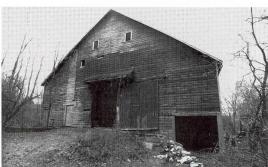
Above: Palen Dutch barn looking southwest. This
photo shows how the right side aisle was originally built lower
than the left aisle and threshing floor to accommodate the sloping
terrain. The exterior doors and siding are not original. All
photos by Peter Sinclair.
Below: Palen House looking west. The dormer windows
in the roof and the open porch are recent additions. Ten two-panel
shutters were found in the cellar. These originally flanked the
windows and added an impressive decorative effect to the facade
of the house.
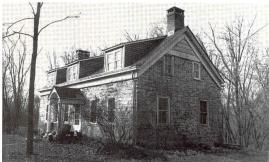
In the Netherlands many types of timber frame barns developed
from the prehistoric aisled-house model to suit regional and individual
tastes.(1)
The first carpenters and farmers of the Hudson Valley chose the
simple anchorbeam aisled-barn type and later generations maintained
its basic true form, it seems, until the last-half of the eighteenth-century.
The Palen barn represents a regional elaboration of the true-form
Dutch barn. Three of these elaborations are 1) the lowered side
aisle, 2) the U-Barn plan (U-barns are Dutch barns with only one
gable end wagon door due to the last bay in the center aisle being
used for hay storage) with lowered anchorbeams in the back bents
and 3) the open bay. Many variations and combinations of these
changes are found in post-Revolutionary barns in the mid-Hudson
Valley.
The timber frame of the Palen barn has no marriage or two-foot
marks, indicating that it is a square rather than scribe rule frame.
(2) The square rule was a system developed in America that replaced
European scribe-rule methods. Square-rule was a concept of measuring
and joining the frame which saved time and standardized rather
than individualized the cuts. In Pennsylvania, scribe rule was
still being used in the late nineteenth century, but in the mid-Hudson
Valley square rule seems to have been introduced at the beginning
of the century. Local written accounts of its introductions date
to the first decades of the nineteenth century. It seems to have
pre-dated the first written instructions (by Edward Shaw) in the
1830s (4) which were typically less instructive than the oral tradition
must have been.
The Palen House is built of limestone and has a two-room center-hall
plan. There is also a cellar kitchen, a feature that has been found
in other and earlier Dutch stone houses like the 1700 Kipp house
in Dutchess County and, possibly, the 1712 Jean Hasbrouck house
in New Paltz, Ulster County. In addition to the barn and house,
there are the partial remains of a three-bay banked carriage barn
that seems contemporary with the other buildings.
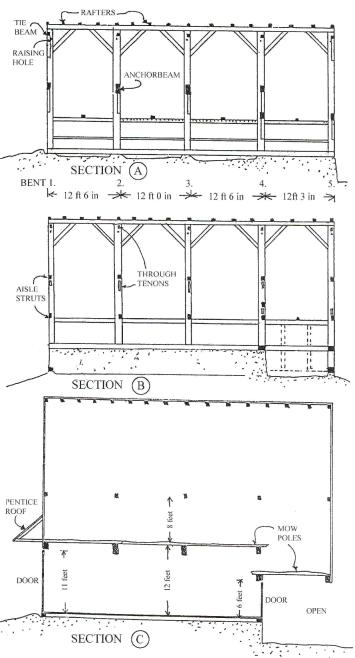
Longitudinal sections-In all the aisle bays of
section A and in aisle bay 4 in section S, aisle struts between
the bents are joined to alternate side wall posts and rest on
the longitudinal struts. This is a later method of timber framing6
often seen in house frames to increase the number of joists without
using more bents and may imply a more permanent floor above the
horse side aisle, Center section C shows how the lowered beams
in the back bay form a lower hay storage area and give better
access to the main loft in the front three bays. All drawings
with this article by Peter Sinclair.
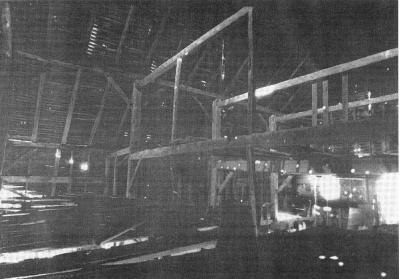
Interior of Dutch barn looking North toward the
right side aisle. Notice the lower loft bay over what would normally
be the center threshing floor aisle (in this case an open bay)
in the foreground (bay 4). This shows how a wagon could not have
been able to enter at one gable end of the barn and exit at the
other gable end as is the case in a true form Dutch barn. This
particular style of barn has been seen in several cases throughout
the range of Dutch barns (Deertz barn, Schoharie County, NY and
barn at the Bronck House, Greene County, N.Y.) and is called
by the author a "U-Barn".
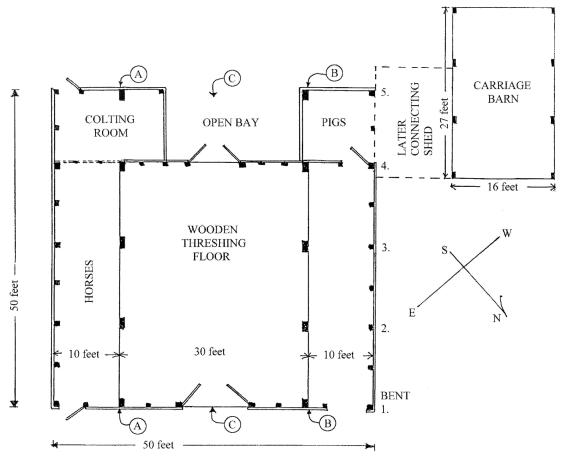
Floor plan of the Palen Dutch barn. There is some
question as to the original plan of the barn. Manger evidence
in the left side aisle in bay 2 and 3 indicate space for four
horses and a colting room on the end in bay 4. The use of the
right side aisle is unclear. There is no evidence of cows but
this may be gone. The space in bay 4, right side aisle originally
had a four foot ceiling on its first level suggesting it was
for pigs. A similar pig pen was part of the original 1813 construction
preserved in a nearby barn (Bogart barn).
All three buildings have timbers reused from earlier buildings.
The property is rented and the barn is unused. There are a number
of structural problems developing in the barn that need attention,
yet, paradoxically, it is often the neglected barn and house that
contain the best aboveground archeological information.
The back doors to the open bay, their hardware and some clapboard
siding to the side of the doors is the only original external surface
of the Palen barn surviving. The clapboards contain the carved
letters "FRP,"
probably for the original owner, and above the letters is a larger "AL"
perhaps for the builder. John Fitchen, author of The New World
Dutch Barn(5), visited the Palen barn in 1965 and numbered it 66
of the 76 he documented in New York and New Jersey from 1962 to
1965. Of the eight Dutch barns that Fitchen documented in Ulster
County in the 1960s only three remain standing in the 90's, giving
a sense of their rate of destruction. I know of eight or nine Dutch
barns remaining in the township of Marbletown and maybe some are
still undiscovered.
Fitchen described the Palen barn as a "4-bay, about 50 feet
long, N-S orientation." My compass says, "N-E to S-W
orientation,"
reminding us to always question the written word and the accuracy
of a scientific instrument and the person who interprets it.
Fitchen went on to observe, "Wagon entrance to threshing
floor occurs only at north (northeast) gable end. Unplanked floor
of southernmost bay (open-bay) is about 5 feet below level of threshing
floor. Two anchorbeams (bent 2 & 3) are 10" x 14 3/4" in
section. Where drop in floor level occurs, two beams (bent 4) 6
1/2" X 8 1/2", and one above the other, serve in lieu
of an anchorbeam. One alone of the anchorbeam braces (bent 1) is
curved instead of a straight diagonal member. Anchorbeam tongues
do not project(6) pairs of rafters. Regular pattern of very short
sway braces (3 1/2' legs on purlin braces)."
| The author has studied early American
structures extensively, especially in Ulster County, New
York. He is coauthor of the book "Town of Rochester,
Report on Historic Barns and Timber Framing" and has
written several other reports on subjects such as thatching,
five-plate wall stoves and early Ulster County houses. This
article is one of several that he has written on Dutch barns
for the Newsletter. |
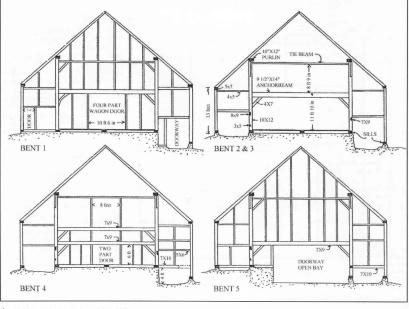 Bent
sections of Palen Dutch barn. Unlike the true form Dutch barn
in which the internal bent sections are all the same, like Bent
2 and 3 of this barn, the design of bents 4 and 5 is altered
to eliminate back wall wagon doors and develop a larger space
for hay storage. Fitchen is correct in calling the lowered beam
in bent 4 "in lieu of an anchorbeam"
because it is not as massive as the internal anchorbeams of bents
2 and 3, and because it is not a free span but supported by posts
and studs. Bent
sections of Palen Dutch barn. Unlike the true form Dutch barn
in which the internal bent sections are all the same, like Bent
2 and 3 of this barn, the design of bents 4 and 5 is altered
to eliminate back wall wagon doors and develop a larger space
for hay storage. Fitchen is correct in calling the lowered beam
in bent 4 "in lieu of an anchorbeam"
because it is not as massive as the internal anchorbeams of bents
2 and 3, and because it is not a free span but supported by posts
and studs.
Part Two has the notes on Palen Dutch Barn and House.
NEWSLETTER,
FALL 1998, Vol. 11, Issue 2,
Part Two
|